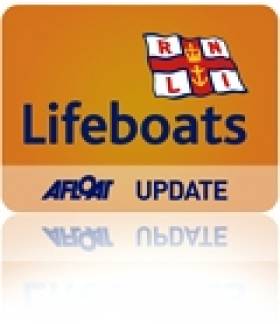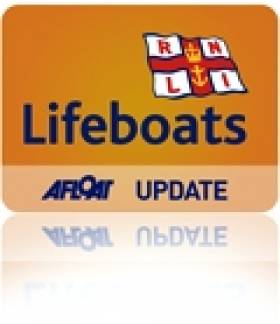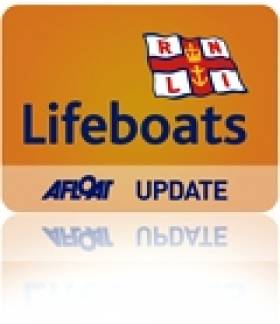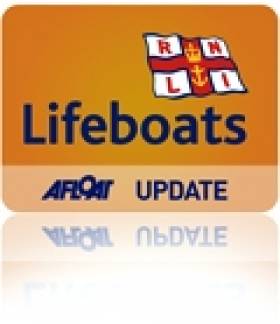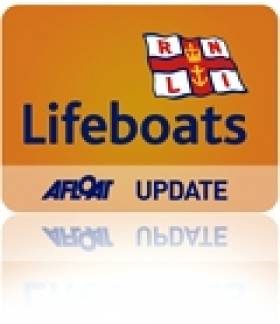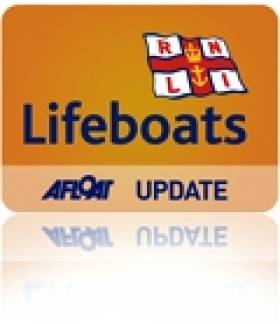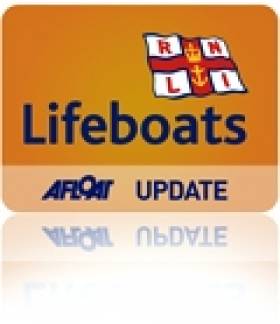Displaying items by tag: RNLI
Bundoran RNLI Assists Search for Overdue Boat off Sligo Bay
#rnli – Bundoran RNLI lifeboat was launched yesterday afternoon to assist in the search for a vessel which failed to return at its appointed time. The search was centred around the Streedagh area of County Sligo. Sligo Bay lifeboat was also launched to assist in the search in poor visibility conditions as were Killybegs coast Guard and the Sligo based Rescue 118 Helicopter.
Following a search of around 25 minutes, the overdue vessel was found grounded near Milk Harbour. The boat owner was airlifted to Sligo General Hospital and his condition is unknown.
Baltimore Lifeboat RNLI Secure Sinking Fishing Vessel
#RNLI – Baltimore RNLI responded to a call involving a 20-metre steel fishing vessel with two people on board yesterday evening (Saturday 7 September).
The vessel was making passage from Castletownbere in West Cork to Kinsale when it began to flood due to problems with sea valves.
The Baltimore RNLI's all-weather lifeboat responded within minutes of the call just after 6pm, proceeding to rendezvous with the stricken vessel two miles south of Brow Head near Crookhaven, Co Cork.
The volunteer crew attempted to secure the safety of the Kinsale based fishing vessel by putting a salvage pump aboard to drain seawater from her bilges. The lifeboat then took her in tow while the crew of the fishing boat worked on her engines.
The engines were restarted and the vessel began to make her own way for a time, but after the engines failed again the tow had to be restablished and the lifeboat continued to tow the fishing boat to Baltimore Harbour.
Baltimore RNLI coxswain Kieran Cotter said: "It was fortunate that it was a fine night. We were able to transfer the salvage pump and establish the tow without a hitch."
On board the Tamar class all-weather lifeboat Alan Massey were coxswain Kieran Cotter, mechanic Cathal Cottrell, Ger Sheehy, Aidan Bushe, Ronnie Carthy, Eoin Ryan and Pat Collins.
New Skerries Lifeboat Dedicated In Special Ceremony
#RNLI - Skerries RNLI officially named its new Atlantic 85 lifeboat Louis Simson at a special ceremony held today (Saturday 7 September), as reported yesterday on Afloat.ie.
David Delamer, a member of the Irish Council of the RNLI, accepted the lifeboat and her launching carriage on behalf of the RNLI before handing her over into the care of Skerries Lifeboat Station.
He paid tribute to the donor, Charlotte Simson, who had generously funded the lifeboat through a gift left in her will. The legacy was 75 years old.
Simson, who hailed from Salem in India, funded the lifeboat which has been on service in Skerries since February, in memory of her husband Louis, from London.
"Mrs Simson made provision in her will for a trust fund that would provide various relatives with a modest income for life," Delamer explained. "She arranged that once the trust fund had come to an end, the remaining money should fund an RNLI lifeboat to be named in memory of her beloved husband. Now three quarters of a century on, Mrs Simson’s wish will be granted."
Leo Cody, a founding member of the Skerries RNLI inshore lifeboat station and a former deputy launching authority, then officially named the lifeboat during the ceremony.
The new state-of-the-art Atlantic 85 lifeboat was introduced into the RNLI fleet in 2005. The lifeboat is 8.4 metres in length and weighs 1.8 tonnes. Improvements on its predecessor include a faster top speed of 35 knots, radar, provision for a fourth crew member and more space for survivors.
Since the new lifeboat went on service in Skerries, there have been 24 call-outs and 49 people have been brought to safety.
Niall McGrotty, Skerries RNLI lifeboat operations manager, said the naming ceremony and service of dedication was a special occasion in the history of the Skerries lifeboat station, adding that the volunteer crew was grateful to Simson for her generous legacy which had funded the lifeboat.
He added that the RNLI could not operate its lifeboats without the dedication of volunteer lifeboat crew.
"The crew in Skerries give 100% at all times. Their commitment and ongoing attendance for training both here and at the lifeboat college means that they are highly proficient in the operation of their lifeboat.
"Further testament of the dedication of the crew is their knowledge that they may risk their own lives in the service of others. There is nothing greater that a person could offer and they deserve nothing less than the best lifeboat, equipment and training that money can buy."
McGrotty went on to pay tribute to the vital support provided by the volunteers who support the crew.
"The lifeboat crew and I are only one part of this station. I must mention our operation team, supporters and fundraisers who volunteer their time and efforts and do so much for Skerries RNLI. These are people of all ages who give what time and money they can."
A crowd of well-wishers turned up to see the lifeboat officially named, with a bottle of champagne poured over the side of the boat before it launched at the end of the ceremony.
Among the guests were Des Frazer, president of the Skerries RNLI Lifeboat Management Group, who welcomed guests and opened proceedings; Leo Cody, who back in 1967 was appointed the honorary secretary of the Skerries fundraising branch and is a former deputy launching authority; and Brian Carty, a former crew member, deputy launching authority and chairman, who delivered the vote of thanks.
Father Richard Hyland, Reverend Anthony Kelly and Reverend David Nixon lead the Service of Dedication.
Dedication of Skerries Atlantic RNLI Lifeboat
#rnli – A new Atlantic 85 lifeboat for Skerries RNLI is to be officially named Louis Simson during a ceremony at the lifeboat station in the north county Dublin coastal town at 2pm tomorrow, Saturday 7 September. The lifeboat which went on service in February was funded by a 75-year-old legacy from the late Charlotte Jordan Simson in memory of her husband Louis.
Charlotte who hailed from Salem, India, married Louis Simson, a native of London, in 1882. The couple relocated to Tasmania where Louis was a mining agent and stockbroker. Following his death in 1922, Mrs Simson returned to the UK where she lived in Paddington London until her death in September 1938. Mrs Simson made provision in her will for a trust fund that would provide various relatives with a modest income for life. She arranged that, once the trust fund had come to an end, the remaining money should fund an RNLI lifeboat to be named in memory of her beloved husband.
Now, three quarters of a century on, Mrs Simson's wish will be granted when Leo Cody, a former Deputy Launching Authority and one of the founding members of Skerries RNLI station, will officially name the lifeboat.
Niall McGrotty, Skerries RNLI Lifeboat Operations Manager said: 'This is a very special occasion for our lifeboat station and we are most grateful to the late Charlotte Simson for her generous legacy which has funded our lifeboat, Louis Simson. Since the lifeboat went on service earlier this year, there have been 24 call outs and 49 people have been brought to safety. We will be proud custodians of this lifeboat, which will go on to rescue and save many more lives in the years ahead'.
The RNLI established a lifeboat station in Skerries in 1854 and a boathouse was built. The station closed in 1930 when a motor lifeboat was placed on service at Howth. The station was re-established as an inshore lifeboat station with a D class lifeboat in 1981. The lifeboat was kept in a stone-built house on the sea front.
In 1997, a B class Atlantic 21 lifeboat was placed at the station for evaluation and a new boathouse was completed in August that year for the Atlantic lifeboat and launching tractor.
The Atlantic 75, B-747 Rockabill, named after a lighthouse off Skerries, was place on service in June 1998.
In 2005, the station was awarded a Centenary Vellum to commemorate an aggregate of 100 years service as a lifeboat station.
Fast, manoeuvrable and reliable, the B class operates in rough weather conditions, capable in daylight up to force seven and at night, to force six winds.
The new lifeboat, an Atlantic 85 is the latest version of the B class, introduced into the fleet in 2005. She is powered by two 115horsepower engines and has a stronger hull and greater top speed than her predecessor. The added radar allows the crew to operate more effectively in poor visibility and she also has VHF direction-finding equipment.
The vessel also has a manually operated self-righting mechanism which combined with inversion-proofed engines keep the lifeboat operational even after capsize. The lifeboat can also be beached in an emergency without causing damage to its engines or steering gear.
The Atlantic 85 carries a full suite of communication and electronic navigation aids, as well as a searchlight, night-vision equipment and flares for night-time operations.
The RNLI is a charity which relies on voluntary contributions and legacies.
Bundoran Lifeboat Crew To Push The Boat Out This Saturday
#RNLI - Bundoran RNLI's annual boat push will take place this Saturday 7 September as the volunteer crew once again embark on the challenge of raising funds for the lifeboat station, which is entering its 40th year of existence.
The boat push will start outside the ambulance base on the Donegal Road in Ballyshannon at noon and members of the lifeboat crew will have buckets with them on the route for people to make a donation.
The route will take them through Ballyshannon, Finner and into Bundoran, finishing at the lifeboat station at Bundoran Pier, covering a distance of almost 10km in four to five hours.
The fundraising drive is just one of the events which helps to run Bundoran RNLI and keep the Atlantic 85 lifeboat William Henry Liddington maintained and ready to go at a moment’s notice.
The volunteer crew counts on the generous support of the public to ensure that the RNLI can continue to provide all year search and rescue coverage and we hope to get lots of support on Saturday.
"The boat push has now become an annual fixture in Bundoran RNLI's fundraising calendar and is something the volunteer crew at the station look forward to each year," said Bundoran RNLI volunteer lifeboat press officer Shane Smyth.
"Not only does it give us a chance to raise much needed funds to continue to run this voluntary service, it also gives us a chance to meet our supporters from the area who continually donate to us despite the tough financial times we find ourselves in."
Isle of Man Lifeboat Launches To Stranded Kayakers
#RNLI - Douglas RNLI lifeboat on the Isle of Man was launched last night (4 September) at the request of Douglas Coastguard following the report of two kayakers stranded on the seaward side of Douglas Breakwater.
The RNLI all-weather lifeboat Sir William Hillary was launched under the command of volunteer deputy second coxswain Graeme Cushnie, to assist the coastguards by illuminating the scene from seaward, allowing coastguard rescue officers to negotiate their way down the sea defence wall and bring the kayakers to safety.
Both kayakers having been reported as safe and well the lifeboat was able to recover both kayaks from the Irish Sea to the visitors’ pontoon at the Battery Pier.
Wicklow RNLI Helps Charity Reach Almost 1.5 Million People via Social Media
#rnli – Wicklow RNLI have become the first Irish lifeboat station to have a rescue featured in the charity's #SaveWave campaign. Some of this summer's most dramatic rescue stories featuring volunteer lifeboat crews have been shared with nearly one and a half million people through the charity's innovative social media campaign.
Launched during August, the campaign has already surpassed its original target of sharing RNLI rescue stories with one million people through Twitter and Facebook. The latest rescue story is from Wicklow and features a man suffering from suspected fume inhalation, being assisted and evacuated by volunteer lifeboat crew from Wicklow RNLI.
The #SaveWave campaign encourages the public to share RNLI rescue stories on Facebook and Twitter to create 'waves' of awareness for the lifesaving work that the charity delivers. To help make these waves, members of the public sign up using their social media accounts.
Wicklow RNLI Lifeboat Opeations Manager Des Davitt, said: 'The #SaveWave campaign is all about sharing rescue stories with the public. It is so important that people hear about the lifesaving work that the RNLI's volunteer lifeboat crews carry out every day, as the charity relies on public donations to keep on saving lives.
'We are delighted that the RNLI have chosen a callout from Wicklow to feature in this new campaign and that we are the first Irish one. During the incident the lifeboat crew used their casualty care training to make the man comfortable before transferring him onboard the lifeboat and back to shore to meet a waiting ambulance. The man has since been released from hospital."
Getting involved in #savewave is easy, visit savewave.rnli.org and sign up with a Facebook or Twitter account – or both. Then, two specially selected RNLI rescue stories will automatically be shared through the individuals Facebook or Twitter accounts each week.'
The campaign is not about donating money and signing up to #SaveWave is free. It is about raising awareness of RNLI rescues, especially amongst those who don't usually hear about the great work the volunteer lifeboat crews carryout.
The #SaveWave campaign runs until Sunday 29 September 2013.
The RNLI is the charity that saves lives at sea around the coasts and inland in both Ireland and the UK.
Lifeboat Launches to Cruiser Aground on Lough Derg
#rnli – Lough Derg RNLI Lifeboat launched to assist three people after their 38ft cruiser ran aground in Slevoir Bay, close to Terryglass, at the northern end of Lough Derg.
At 17.450hrs on Wednesday afternoon, September 4, Valentia Coast Guard requested Lough Derg RNLI Lifeboat to launch to assist three people, after their 38ft cruiser ran aground close to Terryglass, at the very northern end of Lough Derg.
The lifeboat launched at 17.53hrs with Helm Eleanor Hooker, Peter Clarke and Jason Freeman on board. Winds were south westerly, Force 3. The lifeboat came alongside the cruiser at 18.17hrs. The vessel was aground on a rocky shelf, in less than two foot of water. The lifeboat transferred an RNLI volunteer to the casualty vessel. The three people on board were unharmed but anxious, they were wearing their lifejackets. The RNLI crew member reassured everyone onboard, then checked their boat for any damage.
When the RNLI crew member was satisfied that the boat was not holed, the lifeboat took it off the rocks and towed it into safe water. Before releasing the tow, the skipper was asked to check drives, forward and astern and steering. Then, with a lifeboat crew member still on board, the lifeboat accompanied the cruiser to the public harbour in Terryglass, where she was left, tied up safely alongside.
Deputy Launching Authority, John Kelly, advises boat users to keep 'up to date charts of the lake onboard'.
The Lifeboat returned to station and was ready for service again at 19.35hrs.
Wicklow Lifeboat In Medivac From Survey Vessel
#RNLI - Wicklow RNLI carried out a medical evacuation of an unwell man from a survey vessel off the Wicklow coast in the early hours of yesterday morning (2 September).
The alarm was raised after the man was suspected to have been overcome with fumes on a survey vessel working near the Codling Buoy. The all-weather lifeboat launched at 2.45am and was alongside the survey vessel at 3.12am.
Conditions in the area at the time were described as moderate sea with wind southwest Force 3.
The casualty was transferred onto the lifeboat by stretcher and as the lifeboat returned to Wicklow, the crew administered first aid and monitored the casualty.
Due to the low tide in the harbour at the time, the casualty was transferred to the inshore lifeboat and landed ashore at 3.50am. He was met on arrival by a waiting ambulance crew who took him to hospital.
Speaking after the call-out, Wicklow RNLI lifeboat operations manager Des Davitt said: "This was a typically professional response by the volunteer crew of Wicklow lifeboat, who launched within seven minutes of being paged."
The all-weather lifeboat crew launched under coxswain Nick Keogh with mechanic Brendan Copeland, Ciaran Doyle, Carol Flahive, Paul Sillery, Graham Fitzgerald and Peter McCann on board. The inshore crew were helm Barry Spencer, Dave O'Leary and Brian Sinnott.
Wicklow Lifeboat Launches To Flare Sighting
#RNLI - Wicklow RNLI carried out a search of Wicklow Bay on Saturday night (31 August) after the Irish Coast Guard received a 999 call to report a distress flare sighting.
Both Wicklow's all-weather and inshore lifeboats were requested and launched just before 9pm and a search of the shoreline from the Six Mile Point and bay was conducted.
Conditions in the area at the time presented a calm sea state and there was good visibility.
After an extensive search of the area nothing was found. The lifeboats were stood down and returned to the lifeboat station shortly before 10pm.
Speaking after the call-out, Wicklow RNLI coxswain Nick Keogh said: "We made contact with some anglers on Kiloughter beach and spoke to the crew of a passing yacht in the search area and they hadn't seen anything."
The crew on the inshore lifeboat were helm Graham Fitzgerald, Dean Mulvihill and Peter McCann. The all-weather lifeboat crew were coxswain Nick Keogh, mechanic Tommy Murphy, Ciaran Doyle, Dave O'Leary, Carol Flahive and Brain Sinnott.


























